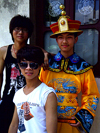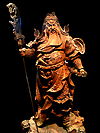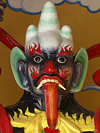qabristan (قبرستان)
Arabic-Persian. Term for a
Muslim
grave, tomb or sepulcher,
derived from the Arabic word qabr (قبر) and related to maqbara (مقبرة),
which means cemetery and is itself associated with the word macabre,
whilst in Thai it is referred to as kubo or qubor (กุโบร์). Though customs and the exact manner of a burial ritual may vary
somewhat by regional traditions, Islamic religious law forbids
cremation of the body and calls for burial of the corpse as soon as possible, without a coffin and with the
head faced towards
Mecca.
Thus if possible, the interment will take place on the same day of
death, often within hours of the actual
death, and it is preceded
by bathing and shrouding the body, and followed by a funeral prayer.
Muslim graves, even of prominent people, such as kings and
high-ranking sheiks, are often nameless and unmarked, or marked only
with a simple grave marker, as in death every soul is equal. See
also
ziarat.
回

qali
(قالی)
Persian-Arabic. Carpets with a size of
180 x 280 centimeters or more. Besides this, there are two more
groups of Persian
carpets, i.e. rugs smaller than 180 x 280 centimeters, that include
prayer rugs (fig.)
and are called qalicheh, and large nomadic carpets, known as kilim
or gelim. Qali are also known as farsh, a word meaning ‘to spread’,
and sometimes transliterated khali.
回
qian kun ri yue dao
(乾坤日月刀)
Chinese. ‘Heaven and Earth, Sun and Moon Sword’ or ‘Universe, life
and livelihood Sword’. Name of a Chinese martial weapon consisting a
bar with sickle-shaped knives attached at each end and in reverse
direction near both grips. It is somewhat reminiscent of a hook
sword or
gou (fig.)
and the
ji
or ji dao (fig.).
回

qibla
(قبلة)
Arabic. The direction of prayer for a
Muslim. In
Malaysia
called kiblat. See also
mihrab.
回

Qi
(气)
Chinese. Literally ‘air’ or ‘breath’, though usually translated as
‘energy flow’. The traditional Chinese character for Qi is 氣, which
besides 气 also includes the character for
rice, i.e. 米. As a
radical, Qi (气) also means ‘steam’ or ‘vapor’, and hence, it is
sometimes interpreted as ‘steam’ rising from ‘rice’ as it cooks.
Besides this, it may also be translated as ‘to get/make angry’.
According to one Chinese creation myth, the original Qi was split
and divided during the formation of the Universe, once the stem of
the
Tao had been grown from its root,
i.e. obscurity. Also transliterated chi and ch'i.
回
qiang (枪)
Chinese. ‘Spear’. A
Chinese long weapon, which consists of a
long wooden
handle,
with a leaf-shaped metal blade, and red a tassel tied just below the
blade. It is used as a
martial weapon in traditional Chinese martial arts. Its
technique is considered a basis
for the use of many other
martial weapons and the
spear technique is hence often
trained as a the first weapon for apprentices of
martial arts.
回
%20long%20weapon%20in%20traditional%20Chinese%20martial%20arts%203_small.jpg)
Qi Gong (气功)
Chinese. ‘Vital breath cultivation’ or ‘air achievement’. A
Chinese
system of deep breathing exercises that involve working with
Qi, the
energy within the body. Whereas the Chinese word qý literally means
‘air’ or ‘breath’, it is often translated as ‘energy flow’, and the
word gōng (功), is the same character as used in the term Gong Fu,
better known as
Kung Fu,
and is itself a compound word of two other characters, i.e. gōng
(工)
and lý (力),
of which the first means ‘work’ and the latter (lý) ‘strength’,
‘ability’, ‘power’ or ‘(physical) force’. The objective of Qi Gong
may be medical, therapeutic or spiritual, but it is also
performed as a component of some Chinese martial arts. It is
practiced in the form of breathing and movement exercises, that
benefit health by creating calming effects and a sphere that reduces
stress. It is seen as a spiritual, slightly mystical aspect of
Chinese traditional medicine and is associated with Buddhist and
Taoist
martial arts and
meditation practices.
Chang Kuo Lao (fig.),
one of the
Eight Immortals (fig.),
is said to have been a master of
Qi Gong.
In East Asia it is practiced widely in public parks and in Thailand
it can be observed in
Bangkok's
Lumphini Park,
early in the morning,
just after daybreak, around the time when the monks are out on
bintabaat.
Also transcribed Chi Kung.
回
qila
(قلعه)
Arabic. A fort or fortress.
回
Qing Dynasty
Chinese Dynasty that existed between ca. 1644 and 1911 AD. It was
the last great dynasty of Imperial
China, that ended with child Emperor Aisin Gioro Pu Yi (fig.),
on 1 January 1912. With its rulers originating from Manchuria, this
dynasty is also known as the Manchu Dynasty.
See also LIST OF CHINESE RULERS.
回

Qing Long
Yan Yue Dao (青龙偃月刀)
Chinese. ‘Green
Dragon Crescent
Blade’. Name for the traditional Chinese weapon held by
Kuan U (fig.). It is a type of
kuandao, an ancient halberd-like defense weapon
consisting of a combined spear and battleaxe. It is made up of a
heavy, serrated blade on a 1.5 to 1.8 meter long pole. The blade is
decorated with the motif of a dragon (fig.), hence the name. It may also be
translated Blue or Black Dragon Crescent Blade, as the Chinese word qing means both
‘green’ and ‘blue’, as well as ‘black’. In Thai it
is either called (Dahb or) Ngaw
Mangkon Khiaw Chan
Siaw, ‘Green Dragon Crescent Hook (or Sword)’, or
Ngaw
Nin Mangkon Chan Changai,
‘Dark
Blue Dragon Distant Moon
Hook’.
回

Qing Ming (清明)
Chinese. ‘Clear and bright’. Name of a traditional Chinese festival
on the 104th day after the winter solstice (or the 15th day from the
vernal equinox), usually on April 5 and every leap year on April 4.
It is also known as Chinese All Souls Day and during the festival
the living pay homage to their ancestors by tending to their graves,
whereas during
Ghost Month the deceased visit the
living. Traditionally they will also offer food and burn
gong de
paper paraphernalia and/or hell money. However, people
may also make altars with food in front of their homes with food
offerings to deceased, whose wandering spirits may return at night
to visit, a tradition normally reserved for
Gui Yue,
but it seems that traditions of those festivals are often mixed-up. Likewise, festivities may include setting
lotus-shaped lanterns adrift on water at
sundown (fig.),
reminiscent of the Thai festival of
Loi Krathong (fig.)
and normally done on the Spirit Festival, which is also known as
Water Lantern Festival and in Chinese called
Xia Yuan Jie.
回

Qin Shi Huang Ti
(秦始皇帝)
Chinese.
Name of the first emperor of an imperial and unified
China.
READ
ON.
回
Qi Qiao Jie (乞巧节)
Chinese. ‘Request for an ingenious union’. Chinese Valentine's Day,
which in the Chinese calendar is celebrated on the seventh day of
the seventh lunar month, according to a love story between the
seventh daughter of the Emperor of Heaven and an orphaned cowherd,
who were separated from each other and are allowed to meet only once
a year, on that
particular day. The story relates of a good-looking but poor boy, whom
—after his
parents died— lived with his elder brother and sister-in-law. His
brother had inherited the deceased parent's house and the land,
while the boy inherited an old ox. Hence the boy was put to work
with his ox, farming his brother's fields, and he was referred to as
the cowherd. However, the ox was in fact an immortal from heaven,
who was banished from heaven for some mistakes. One day, the ox
advised the boy to go to the farm's brook. On arrival there, the boy
found the seven pretty daughters of the Emperor of Heaven bathing
there. Spellbound by the youngest and most beautiful one, he
secretly took away her fairy clothes. When the other six fairies
went away after bath, the youngest couldn't fly back without her
fairy clothes. The handsome cowherd then appeared and told her that
he would not return her clothes unless she promised to marry him,
which she did. However, being the daughter of the Emperor of Heaven
who was in charge of weaving the clouds and rainbows, the Emperor of
Heaven thought that without her skills the skies weren't pretty any
longer. So, he had her returned, carried away into heaven by her own
grandmother. One day, the old ox was dying and told the now saddened
boy that he should keep his hide, because -since he was formerly an
immortal- it had magical powers. Using the hide, the boy was able to
fly into heaven, but before reaching his wife, the grandmother made
a milky way in the sky with her hairpin, which kept them separated.
Though, compassionated by their love, the Emperor of Heaven allows
the couple to be together once a year, on the evening of the seventh day of the
seventh lunar month. To facilitate their annual reunion, magpies on
that day will fly
up and form a living bridge that crosses the milky way barrier.
Compare with
Matanapatha.
回
Qiu Chang Chun
(丘长春)
Chinese. A Master of Alchemy and renowned as the founder of the Long
Men (龙门) or Dragon Gate sect of
Taoism,
an offshoot of the Northern school of
Quan Zhen, itself another a major
sect of Taoism. Long Men rose to prominence in the 13th century, by
combining three religions, i.e.
Buddhism,
Confucianism and Taoism, and is today the largest existing branch of
Taoism in the world.
Chang Chun means ‘Always Joyful’ or ‘Eternal Spring’, yet Qiu Chang Chun is also known by
the name
Qiu Chu Ji.
回
_small.jpg)
Qiu Chu Ji (丘处机)
Another name for
Qiu Chang Chun.
回
qiuqian (求籤)
Chinese-Mandarin. ‘To seek a lot’. Mandarin name for
Chinese fortune sticks.
回
Qi Ye (七爷)
Chinese.
‘Seven Grandfather’. Name of a
Taoist
deity, who was a general and the best friend of
Ba Ye (八爷), i.e. ‘Eight Grandfather’. He is a popular deity often
seen as a giant puppet in street parades, usually together with Ba
Ye. Qi Ye (fig.) is always portrayed with his tongue sticking out, because
he hanged himself in mourning for Ba Ye, after the latter had
drowned himself. He usually also depicted with very large ears (fig.).
He is popular in
Vietnam, where he is often placed in temples
opposite of
Ho Phap Vi Da
(fig.),
i.e.
Wei Tuo
(fig.),
whereas in
China,
he is associated with Gui Wang,
i.e. the ‘Demon King’ (fig.).
回

quadriga
Latin.
‘Four-in-hand’. A chariot harnessed with four draught
horses lined up next to each other.
回

quail's egg
See
khai nok kra-tha.
回
quan
(观)
Chinese. A place of worship for
Taoists.
回
Quan Zhen (全真)
Chinese.
‘Complete
Perfection’.
A school of
Taoism
that specializes in Nei Dan (內丹), i.e. Internal Alchemy or Spiritual
Alchemy, which consists of a series of
physical, mental, and spiritual disciplines, aiming at prolonging
ones physical life and at creating an immortal spiritual body for
the afterlife. Nei Dan techniques gradually replaced Wai Dan (外丹),
i.e. External Alchemy, which experimented with the ingestion of
herbs and minerals, but often ended in fatal casualties, such as
in the case of
Qin Shi Huang Ti (fig.), the very first emperor of
an unified
China,
who died of mercury poisoning, after consuming the matter, with the
intend to gain longevity and immortality. Focusing on the internal
cultivation of the individual, Quan Zhen also pursues the principles
of
Wu Wei.
回
Queen
Saovabha Memorial Institute
Medical institute in
Bangkok,
that is part of the
Thai Red Cross Society.
READ ON.
回
Queen Sirikit Botanical Garden
A garden in the forested mountains of the
ampheu
Mae Rim, in
Chiang Mai Province,
dedicated to the collection, cultivation, and display of a wide
range of mostly subtropical and tropical plants, labeled with their
botanical names.
READ
ON.
回
Queen Sirikit Museum of Textiles
Name of a museum located within
the compound of the
Grand Palace in
Bangkok and housed in
Ho Ratsadakon Phiphat
(fig.), the former
office building of the Royal Department of Tax Revenue, which was
built on the site of earlier army barracks.
The museum was established in 2003, under the auspices of Queen
Sirikit Kitthiyagon,
with the intend to publicize Thai textiles. The state-of-the-art
museum consits of modern galleries, an education studio, a library,
a lecture hall, and Thailand’s first dedicated textile conservation
laboratory. During the
transformation of the former
office building into the museum, a new lobby was added and
fascinating traces of the building’s 19th century origins were
discovered, including a pediment ornament bearing the emblem of King
Chulalongkorn,
and a cache of 33 cannonballs, relics of the site’s military past.
See also POSTAGE STAMPS (1)
and
(2), and
MAP.
回
_small.jpg)
Queen Sirikit National
Convention Centre
Name of a large exhibition hall
and convention center in
Bangkok,
that opened in 1991.
READ ON.
回
quincunx
Latin. A square platform with
five towers, one in each corner and one in the middle, such as e.g.
Angkor Wat
(fig.),
built to resemble mount
Meru.
回